-
Posts
650 -
Joined
-
Last visited
Content Type
Profiles
Forums
Developer Articles
KSP2 Release Notes
Bug Reports
Posts posted by GarrisonChisholm
-
-
I built a space plane and when it was deployed to the tarmac an oscillation left and right began. Which amplified. With or without SAS.
Until it shook itself off the runway and started shedding parts.
Fun.
-
I have a glorified word-processor I bought 2 years ago for $400 new out of the box. It has a 2 gig AMD A8 processor and only 2 gig of ram, and no dedicated graphics card. A large complex rocket can give me 2-3 fps at launch and it can take over an hour to get to orbit, and i STILL have fun. The fun of this game is in the engineering and deployment-to-use, so lower frame rates become (I believe) more tolerable. Though mind you I am NOT saying I wouldn't enjoy it much more at 30 fprs.
I wrote a long-term mission report for a while and have many mods installed, including EVE (though trimmed), and it was useful for all of that. I do have to unload the game and re-start after 4-6 hours, as once it loads more than a handful of screens or vessels it slows down in loading new screens a lot.
-
No pictures (yet), but I will do my best to paint with words.
The Program has a contract for science from the surface of Eve! So I designed a delightful little Soviet-style lander, and was quite tickled to see it pass through re-entry with only moderate damage. I managed to miss the large continent I had targeted however, and was heading for a water landing. Oh well, thought I, at least with an inflatable heat-shield it will float!
Little did I realize they were inflated with lead.
Ah! But this is excellent! I can now 'land' on the floor of the ocean, and still use all my soil analysis tools! If I can transmit from the ocean floor it will work!
Then at 118m everything crushed. :|
Floating to the top of the sea, incredibly, all that survived is; the Octo probe core, 2 batteries, a communitron 16, and 1 tiny solar panel.
One survived communicating probe, ... zero science that can be done.

-
-
The probe has some Dv, yes, though only enough to change course. Maybe I'll sketch up a diagram and get some screen-shots when I'm home later, but the Orbiter was going to use Dv insertion and so not touch the atmosphere, but the entry probe would be on a closer orbit to intersect of course, so it would be out-pacing the orbiter until the atmosphere started to slow it down. I can't put a big transmitter on the probe because entry would tear then off, so I need to stay within 1,5m M and LoS to make sure i get the data.
-
Good day one and all. I am embarking upon an exploration of the gas giants (out planets mod) and my plan calls for a probe stage in three parts. A gas giant entry probe, to be detached after entering SOI, an orbital insertion stage that when decoupled from the orbiter itself will serve as a potential relay, and then the orbiter itself.
My issue is, as I start to think about it, how to ensure that the entry probe stays in communication with the orbiter/insertion-stage as it enters the planet's atmosphere. Logically the probe would seem to need to slow down after separation, or else the entry probe might circle around the planet and depart line of sight and lose data transmission.
Does anyone have a "method" to ensure this works out, or do I just have to play with varying angles and try to make it work?
-
See that? 25km off target, but I made it to this beautiful valley where I need to do my biological experiments.
Anyone care to guess what is NOT going to be happening? :| Experiments. Or anything. The last command I sent was to apply the breaks when I caught some air at 20 m/s. Unfortunately, the probe core - like an idiot - was mounted right at the front there. Where there is nothing now. :|
Sigh...
-
On 12/25/2018 at 11:34 PM, CatastrophicFailure said:
Year 13, Day 119...
So, after locking up ALL the fake mai tais in Triti's room- where they'll be extremely secure (oddly enough she had no gripes about guarding them)- the engineering team has come up with a potential solution. Which mostly involves going around in a rush bolting on a bunch of extra stuff to a nearly-finished rocket that was already threatening to tip the scales beyond what the new launcher could loft <breath>. And then not testing the setup at all. Not even simulating it.And, of course, launching at night.
So, of course, the tug runs out of fuel before it can rendezvous with our nascent station. The new module is decoupled short of its goal...
...and left to make the final approach on its own, rather anemic, engines. This raises the further complication that, without the tug, there's no way to generate power. Fortunately, the one thing the module does not lack after the flurry of activity, is battery power.
All that mess should be enough to last about six days.
The rest of the approach goes off without a hitch, but we're still in the same boat- er, station... well no one is actually in it, but anyways... as we were before. The module is unable to dock successfully. The latches won't close. Even with an extra battery on the ring, we can't even hook up temporarily to keep the two craft in place.
Seriously, you guys are rocket scientists, can you not figure out a simple tape measure?!
We were sort of expecting this. So at the next pass of the Space Center under the station's orbital plane, it's Bob to the rescue!
Along with Triti and Jencine. No one asked about the mai tais.
And right away, we have another problem, that some how also didn't show up despite extensive testing...
Bob was pulled early from its Doug-standard retrofit for this mission, so while it is packing an upgraded Gandalf-D engine, and an upgraded booster to boo(s)t, the assembly team never got around to installing some minor details, like, oh, say, Doug's upgraded power generation. Or food and water. Or, I dunno, how about--
NITROGEN!
Yes, somehow Bob with two Kerbals on board has been launched into a harrowing rescue mission with absolutely no nitrogen on board, and begins hemorrhaging atmosphere as soon as it leaves our own.
And somehow, no one involved, including the crew, actually noticed this for several hours.
Am I the only one paying attention around here?It seems someone on the engineering team is still having a bit too much fun with that 2mm drill bit.
So now a mad rush is an even madder rush. Triti manages to catch up to and dock with the new module drifting in space before the two of them suffocate. But due to some odd quirk with the power systems, the moment the two ships make contact air begins flowing one way while electricity begins flowing the other, at a rather disturbing rate. Yes, despite the fact that Bob's meager solar arrays had no trouble powering the ship with only two two crew aboard, some mistranslation in some bit of software somewhere has the new module bleeding power worse than Bob is bleeding air. Where it had been sipping its own reserves just a moment ago, it's now sucking down the juice faster than a certain other group and those frequently-mentioned mai tais. (is this a thing, now?), and the solar panels can't possibly keep up. And there's no way to shut any of it off.
Seriously, who's writing this stuff?!So now it's all up to Triti, who has to use Bob as a tug way beyond what it was ever rated for, rendezvous again, complete the mission, then get both crew home before they ether freeze to death or suffocate.
As luck would have it, it's, well, Triti...
As gently as you would generally expect Triti Kerman not to be, she saunters the module right up next to the main station node, and holds it there...
Then it's all eyes on Jencine...
Apologies in advance.
Hey!...who looks nice and warm in her suit with all that extra insulation.
Stop talking about my chest hair!
I thought you didn't have chest hair...
Gah!Er, anyways...
Undoing with clumsy gloves and a single screwdriver what it took a an entire trained crew of guys with supposedly surgical precision, and then re-doing it all again, Jencine rekajiggers the main node, swapping around docking ports and batteries until there should be no more interference issues.
There should be no more... and yet we still can't get a hard dock. Perhaps something got jostled by Jencine HEY!, or perhaps it's some resonance with the grossly off-center masses, but the stack won't stabilize.
150 tonnes of spacecraft just sit there, wobbling back and forth ever-so-slightly, using up resources we can't spare.
Oddly enough, it's the night janitor who comes up with a solution, claiming he did some silly thing called "reading the manual." At any rate, despite doing so being a clear violation of the very laws of physics, thermodynamics, metallurgy, and probably a lot of other things, it seems it's actually possible to weld the two modules together without having them actually docked. It's mostly a case of nulling out the motion as much as possible, then waiting for juuuuust the right moment and--
Success!
Mostly.
Wait, did it work? Why is there a part still there? What's happening?
Once the smoke clears (which also shouldn't happen in space, but it seems janitors are not troubled by these inconsistencies) the new module seems perfectly fuzed to the structure!
Oh, NOW you get out the tape measures! Well put them away, no one is to measure this too close! Looks good enough from here. Besides, they won't reach...
Jencine pops back out again to give a quick fix to a balky RCS arm...
...and now we're back to the problem at hand. Once linked up, the power loss gets even worse, even with the interim propulsion module's larger solar arrays. So there'll be no opening the hatch and taking in that new space station smell for these two. Instead, Triti and Jencine take a deep breath from the nitrogen feed before undocking and heading home.
...and we'll just chalk it up to the fact that there was no oxygen in that breath as to how Triti managed to miss the landing target.
But, with the main node (possibly) back in good working order, we can forge ahead with the rest of assembly!
We hope.
That water in the last shot looks amazing. You balanced it well!
-
I'm going to shamelessly give this corpse a kick, as it the idea would provide for Kuiper Belt bodies and might be of current-event interest, on the off chance that someone with the code wizzarding skills might take the idea and run with it.
-
Be fortunate the kerb isn't spagetifiing away at trans-light speed. I haven't seen that behavior recently, but it has been known to happen on rare occasions.
-
Well, this is a link for the think-tank we had back then. I had one person much smarter than I say it could be done, but I tried several avenues and the ones I thought were viable were non-starters.
-
Oktober 1st, '64
Mortimer sat at a mechanic's desk in the Air Force space-plane hangar, the large craft itself now nearly half disassembled.
It was easy to see why it had never made it to orbit, even to him. It had clearly been designed by someone who thought the only answer to drag was "moar power", and the pilots had been told that a "standard" re-entry included the phrase, 'when the uncontrollable tumble begins immediately deploy the chutes or you may not regain consciousness to do so before impact.' Comforting. Parts were even now being cataloged and deemed 'store' or 'dispose' by KSC technicians, and then loaded on the appropriate trucks. Mortimer was itemizing the parts that would be disposed of and calculating the expected remuneration they'd get back.
Since the 'complete confidence' lawmaker's briefing, Mortimer's primary job had been complete. He had originally been brought in to ensure that the KSC survived its spartan early funding period, and with the CA decision to divert half of the last year's Air Force space-plane budget to the KSC there would be so much cash that even Gene would be hard pressed to spend them into ruin. That being said, there was no reason it had to be Mortimer sitting here doing part notations in an unheated hanger on a chilly morning. He could have sent his assistant. However Mort was trying to find an answer to a larger question.
In-between the technicians jogging up and dropping off slips of paper, Mort was going through the construction and concept documents for the Munex Initiative. The space plane had been born of a desire to ferry cargo frequently to space, and also rationalize the programs co-existence with KSC from a gross horizontal/vertical launch perspective. The Munex Initiative had been born out of a classified briefing given by D-Magic to the CA which highlighted the threat to civilization of asteroid collision. What was most interesting though is that it was not the CA that decided to base asteroid intercepting missiles on the moon, that scheme had been pitched by D-Magic themselves.
The more he read the memos though, the less convinced he was that D-Magic really cared about executing the plan. They seemed far more interested in establishing and ensuring frequent travel to Mun. Frequently they passed off design decision making or even suggestion opportunities to the Air Force, but always offered a firm opinion whenever that would support more numerous cartage trips. He was particularly interested in specifics of the plan that they argued most vociferously for, namely radar observatories at both poles. And every time the question had been raised which pole to start at, they had insisted the north...
Mortimer paused to gaze across the tarmac to the black car that the D-Magic team had arrived at the admin building in. He suspected they had come to collect the box of documents he was currently sorting through. Funny that, that it was here with him rather than over there waiting to be picked up. "I bet they're disappointed" he thought. A kerb in a dark suit wearing dark glasses turned and gazed across the runway towards the hanger before getting in and being driven off. Mort waved from the shadows of the hanger, then went back to work.
'meanwhile...'
Linus walked into Gene's office, where he and Wernher had been having a heated 'heart-to-heart' about his Duna Universal Space Transport. Gene looked up and waited for Linus to speak.
"It is just as we suspected Gene." He looked at Wernher with obvious sympathy.
Gene didn't say anything, having been already convinced, but Wernher spoke sharply.
"Can you truly be sure?!?"
Linus nodded.
"The sun is entering a stage of significant sun-spot activity, such that the astronomy department predicts there will be no period of quiescence lasting the required 2.2 years for at least a decade. As you both know, our radiation shielding can make a single solar flare survivable, but not two. There is no way to fly to Duna with the current spacecraft."
Gene asked, "How many active shields would we need?"
"70."
Wernher said something undoubtedly foul in Kerman and slumped in his chair. Gene spoke.
"Ok, that settles that Linus, thanks. We will need to come up with a new technology solution to fulfill the CA's mandate. I'm sorry Wernher, I know that design has been your baby for far longer than we have had a KSC. It just won't cut the mustard now."
Wernher didn't speak, but his attitude seemed be one of begrudging acceptance.
"Wernher, we'll need to wait until after Linus' team comes up with a radiation solution before we can enter a new design stage. In the mean-time, that means all our "local body" transport rockets will need to be reworked. We can't take a risk on even a Mun shot now."
Both Linus and Wernher appeared demoralized.
"Get going guys! Our problems won't fix themselves!" And Gene immediately pulled out a yellow pad and started writing an inter-office memo.
SpoilerGood evening all. This is just a note on my future game-play. I have spent 4 months trying to get Kerbalism to be stable, and every time I get it so I think it is right something else fails. It is to the point that designs that can fly in a Sandbox year-1 start will not load in year 15+ of my career save, so there is clearly not only an active flights issue but a time-clock issue. The last straw was getting a test vehicle into Duna orbit, but every time I 'switch to craft' the PC would literally reboot. Not CTD, not lock-up or crash, but black-screen & then the typical boot-up display. So, with much regret, I was faced with either losing Kerbalism or losing my game.
Kerbalism is great for the early game and Kerbin-system flights, it adds so much to the game, but I just can't endorse it for anything involving further aspirations. I have loaded USI life-support, as I think that's the one that I enjoyed using before, and I will continue the game.
As the story is no longer being flown with Kerbalism however, I am not sure it qualifies as "interesting enough" to maintain a chronicle of. Many people have gone to Duna with stories/reports, and it isn't uncommonly difficult without Kerbalism. I will maintain notes on my next steps however, and if I get enough feedback I will continue to chronicle the game here.
-
This is why I love this community. Thank you @Snark and All. That was the insight I was hoping for. My plans will now be simpler and more attuned. :]
If I don't screw it up I will post it in the results. If i do screw it up, it will appear in my mission report.

-
9 hours ago, The Aziz said:
Gravity assists. There are tools for that, the most complex I know is KSP-TOT, and believe me, it takes it a while to calculate optional journey, especially when you want to use one planet for gravity assist and go to the other, it has to calculate right time to launch, any potential burns etc.
But you asked a simpler question, and my answer is: you always spend more time on using the gravity assist than going straight forward. You need to go back "down" and "up" again. It all depends on your fuel budget.
Thank you for KSP-TOT, I will look into that. I think my rationale was more time than speed, as I just want to make the journey as short as possible.
Burning 40,000 dv in Kerbin orbit to go straight to Valentine (extrasolar planets mod) will take 33,000 years. Going to Neidon to Kerbol to Jool to Valentine would get me there sooner. I would sacrifice 5 years travel on the front end as I dove back in but in the end it would pay off. End (Planet9 mod) is not so far, only ~40 years (i think), so I don't think a super complex trajectory would pay off. It would be going faster at End, but I doubt it would get there sooner due to the sacrificed out-bound time. That's really the question I am puzzling over. At what point does the inbound leg no-longer make sense. I was trying to find that magic "dividing line."
-
Good evening all, I've a simple (I think) question. I know that if you drop down around Kerbol then your hyperbolic velocity is greater than just burning straight out with the same amount of fuel. I also know that going faster at Periap produces greater velocity, which means dropping from a higher Apoap. So the farther out you go before you drop down, the faster you will exit.
However, at a certain point the benefits of dropping down towards Kerbol must be exceeded by the time you've spent traveling out to your Apoap. In an extreme case, if my target was 1,000,000,000 km out, and I rose to an Apoap of 500,000,000 km, it feels like I may as well have invested that energy in launching directly to the target rather than a sun-skim profile.
Is there an easy way to determine how far out to egress with a sun-skimming plan before it would just make more sense to launch straight out, or am I missing something basic?
-
...What if you fired a ballistic rocket from KSC, with no guidance V2 style, and hit it? Different contest I suppose.
-
4 hours ago, Dfthu said:
God no. It would never happen. That thing can barley fly straight and level.
"Gahd noh. Eet vould never hahppen. Zat ting cahn barely fly straight andt level."
(once every 3-6 months)
-
De-Orbit...
Linus' sim-team had given the go-ahead, so Bill and Bob prepped the ship for the wholly unplanned for event of bringing the Duna Descent Vehicle down on Kerbin.
First the DDS was jettisoned on a sub-orbital trajectory to drop into the ocean.
Then the craft was prepared for re-entry. It had been determined that it would be possible to pump fuel from the Duna Return Stage into the Landing stage to break re-entry, so the needed valves were prepped and then the craft brought into alignment.
As soon as the heat threshold was reached for the folded-away solar arrays, the engines were fired. Now the consumption rate was slightly greater than the pump rate, but re-entry was never-the-less managed without a single part being lost. Every chute was opened, and the engine set to recover the ship in the far highlands.
However, at contact it was discovered that the break rate was just a bit too high, and a brief and alarming cascade failure initiated;
SpoilerA landing leg fails at 6.5 m/s on the 8* slope, and a ripple of shock progresses up the craft, incredibly culminating in the decoupler for the re-entry vehicle.
Shaken free of the toppling craft, Bill and Bob descend on the fortunately still inflated primary chute, which none-the-less cannot provide enough drag for the still attached final stage motors, which detonate upon contact.
However, those components serve as crash buffers, and Bill and Bob alight not so gracefully on Kerbin next to a gratefully non-conflagration, as the massive craft settles mostly intact next to them.
Everyone breathed a huge sigh of relief, and nearly 3 million in Funds were recovered. The world was of course disappointed that their greatest ever enterprise was delayed, but all were thankful that the software errors in the fly-by-wire hub were discovered before the crew had left orbit. Work was enthusiastically begun on a final upgrade for the design before the next launch window 2 1/2 years away.
In the meantime, there were contracts on the books to mind. Crewed missions would be cancelled pending the completion of Duna, however there exists a simple part test that could be easily accomplished. To test a decoupler on solar orbit, QuickCom was built for the modest sum of 10,000 Funds.
Following a Lunar fly-by, the mission was easily accomplished, and the craft later inserted into an inter-Kerbin orbit to potentially support Eve missions.
Work at the KSC progressed, though Gene was puzzled to find that the assistant finance officer was taking over the signing-off of expenses, and no-one could identify precisely why Mort was not on campus...
-
42 minutes ago, Nivee~ said:
There are fish in Kerbin?
 How do they look like?
How do they look like?
And pretty weird for Mort to skip work.....
Maybe he's up to something...

-
25 minutes to Duna Injection Burn...
Everyone was seated again in the conference room, and Gene looked directly at Linus for him to take the floor.
"We can't do it Gene."
Gene harrumphed slightly. "Is it close?"
"If we aerobrake low enough to enter orbit, we lose all the primary solar panels. If we aerobrake far enough up to preserve the panels, we can't enter orbit. If the primary solar arrays fail the secondary panels can maintain operations, but only if we shut down 4 of the 8 Active Radiation Shields. However most of that secondary power comes from the Duna Departure Stage, which is designed to remain in Duna orbit as a supplementary relay satellite; they have to decouple it to land. That would leave only bare minimum solar panels for nominal life support, with no active shields."
"We can't do the mission as planned. We see 4 options Gene."
Gene nodded, "Go on."
"One. We refuel the Departure Stage in orbit. We have 2 Lustre's in storage, we could launch 1 in 4 days, rendezvous, dock, pump all the remaining fuel in and still catch the tail end of the departure window. The bad news is that the involved docking ports were never meant to be mated, both are on sloped facings of the capsule leading to a terribly difficult maneuver. And we would have to do it twice with ungainly vehicles not meant to maneuver on RCS."
"Two. We send up a Lustre, disembark Bill and Bob, bring them home and build a purpose built refueler to refuel DUST in orbit and delay departure until the next window."
"Three. We proceed using the low aerobrake at Duna, then we remain in orbit until 2 days before our departure. If we delay the landing that long, then the crew will only be without radiation protection for roughly 250 days. They could make it; though of course a single solar flare would kill them."
"Or, ... four. We reprogram the ship, set all the parachutes on one trigger, leave the departure stage in orbit, and try to land the whole thing on Kerbin, recovering greater than 80% of the whole flight's expense. Then we have access to those funds for another try."
Gene tapped his pen several times and then just shook his head.
"Wernher, from the outside looking in someone would ask how this ever worked at all!"
"Gene, zat is unfair. We completed multiple successful insertions and landings in simulation. No previous iteration has ever had this difficulty. It was wholly unexpected."
Gene looked at Linus. He wanted to tell him that the data on how massive the battery change was must have been hogwash, but Linus knew that already, and Gene was sure that in the sim team's final report he would admit that.
"Alright. Option 4 is dangerous, but it would mean plenty of time to test it because we'd be under no time crunch. Option 3-"
"Bill and Bob both favor option 3 Gene."
"Well bully for them but it is still insane. I'm sure the CA would be tickled if Kerbin's heroes came back microwaved and glowing some unwholesome color."
"They wouldn't actually be micro-"
Gene bounced a swiftly crumpled paper off Linus' nose.
"Two makes little sense. If we're not launching for this window, why preserve an imperfect craft. We could recover, redesign and build again. As for One, I seriously doubt our first attempted docking should be with two very large craft not intended to dock with one another, and racing against the clock at that."
"No, it is Option 4, or we simply have them return if 4 cannot be proven safe. Questions?"
No-one said anything.
"Alright. Linus, get to work, prove we can do it. Griff, tell them to skip their departure routines. And tell them not to get any funny ideas. Mort would take it out of their paychecks."
Someone chuckled, but no-one would later admit to it. Everyone rose, though Gene exited out to the Admin wing. He needed to get up front with this one, and hopefully the news that most all the Funds would be recouped would soften the blow. Gene arrived outside Mort's door, raised his hand to knock, then paused.
-
Until someone comes out with a band named The Boosters, could there possibly be a more Kerbal group than;
The Struts ?
-
I know it is off topic, but remember the thread we had going a couple years ago about fixing science to the heliopause and interstellar space should you reach that far, that would have been a much easier add and nothing ever came of it, despite seemingly a lot of agreement and support. I would love your geology/search for life biome layer though.
-
3 hours ago, Nivee~ said:
Nice! I want to see how angry Mort gets when he hears this!!

Hah! Mort may have a reaction, but I'm not sure its his 'job' to get angry yet. It is an in-flight mission, and Gene will get quite angry enough for everyone. If it aborts (or fails), then Mort will have a coronary for sure. Right now, it hasn't cost the program any money. :]
edit- check that, losing the mains meant they couldn't be recovered of course, but 4/5's of the stage recovery was successful, and that doesn't always go perfectly so I'm willing to call that 'unfortunate' but within typical norms.
-
April 15, '64
1 year and 12 days after the PCA Duna Directive.
Gene waited while the ground controllers from the morning's launch filtered into the room, some numb, some sheepish, some clearly scared. Gene had just unwrapped a second cigar, as the first had been chewed to pulp. Some bold early arriver had delicately slid a waste bin over towards his chair, but judging by the floor Gene had clearly not cared whether he hit it or not.
The last person into the conference room shut the door behind him, the latch klicking to locked.
Gene managed to stare at everyone at once.
"Alright. DUST is in orbit right now. The most expensive rocket we have ever built. ...I want someone to tell me how we could have BORKED this so Badly!!!"
No one was eager to say anything. Finally Aaron Kerman cleared his throat, only to immediately be shut down by a "From the beginning!" from Gene. Everyone looked at Wernher, who in turn seemed to be surprised anyone was looking at him.
"Zee design vas quite sound Gene, zere vas nothing wrong with construction. Zee build went through 5 iterations, each one simulated until it failed, each one improving upon the previous design. Zee final build vas approved by the simulations team, and the plans sent over to the VAB. ...After construction it was in storage for 80 days awaiting zee launch window. She vas rolled to the pad and fueling commenced."
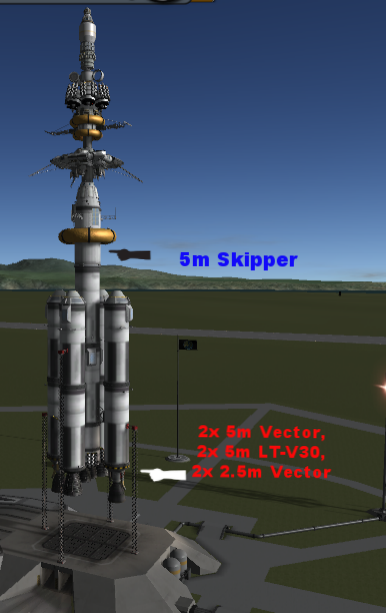
Gene looked at Linus.
"The simulations were successful obviously, and the craft performed all required functions or it wouldn't have been ordered to build."
Linus nodded.
"Of course Gene. After each build the mission was simulated, corrections and improvements made for each bloc."
Gene made a note on his pad.
"After each simulation. So what was the improvement for the final Bloc V?"
"The battery capacity was increased about 42%."
"Right...." Gene nodded. "And of course it was simulated after this improvement, yes?"
Linus flinched slightly.
"The improvement was tiny Gene, there was no nee-"
"Right, not tested. So, Gus, the plans were received and put into fabrication. Were there any build issues?"
"No, no issues Gene! The new engines were received and mounted with no issues."
"Good, good on the new engines. So had these 'new' engines ever been fired before?"
Gus chuckled. "Of course not Gene! They were simply scaled up versions of engines we'd flown before, tweaked so-"
"Engines not tested... right. So, Griffon, what happened after the rocket was loaded on the pad."
Griff Kerman was nominally Gene's peer, so he too seemed a bit miffed about Gene's tone, but he answered.
"Very well Gene. Bill and Bob boarded the rocket. It was immediately noticed that our telemetry was not loading, so we did a few computer start/re-starts until we had our engineering feed."
"The countdown then commenced, and we had a good launch."
"The first set of boosters were jettisoned without issue at about 6km."
"The second set at about 45km."
"Immediately following booster 3 & 4 sep, we starting getting a mounting roll in the craft, presumably from trying to steer prograde. When it got bad enough we shut down steering, then after the oscillation damped out continued to steer."
"Whether from the oscillation or a slightly different launch program," at which Gene raised his eyebrows but said nothing, "we found on MECO that we would need quite a bit of Dv from the Duna Departure stage to make orbit, on the order of 380, vs the expected 150. This deviation was significant enough that after talking it over with the front row, we elected to have the ship complete an orbit before burning at Apo, dipping back down to about 67km. Because of this the crew was instructed to not deploy their solar panels yet."
"When the core stage was jettisoned though, due to our altitude concerns we erred and fired up the DDS sooner than we should have, and the inter-stage was ejected into the main."
"And, ... it was on planning the final orbital insertion burn that we realized the most grievous glitch- the fly-by-wire hub was not working, as we discovered the ship could not align along its needed burn-node. However the ship is in orbit successfully now."
Gene looked back and forth across the faces of his team.
"We have less than 300 Dv for Duna insertion. I'm not sure I would call that a success folks."
Many pen clicks followed while Gene controlled his temper.
"Alright, it looks like we have only done 3 things wrong that could doom the mission, and we're in a quite 'successful' 110x77km orbit."
Gene sighed.
"Linus, you have 4 hours to simulate Duna insertion as-is or I'm aborting. After that I want to know why our launch was so inefficient and why the Fly-by-wire is non-functional. And then I want at least 1 hour without seeing any of you or someone is going to get a pencil in their neck, probably me."
Gene closed his folder with a snap and briskly left, heading to his office and a big list of "Most Important, Call Me" notes from about 50 CA officials.



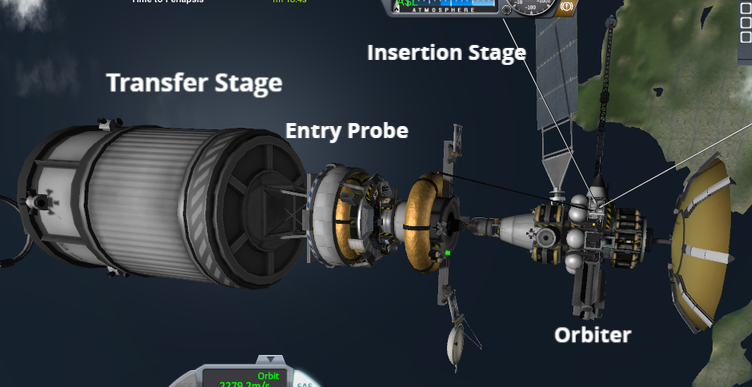
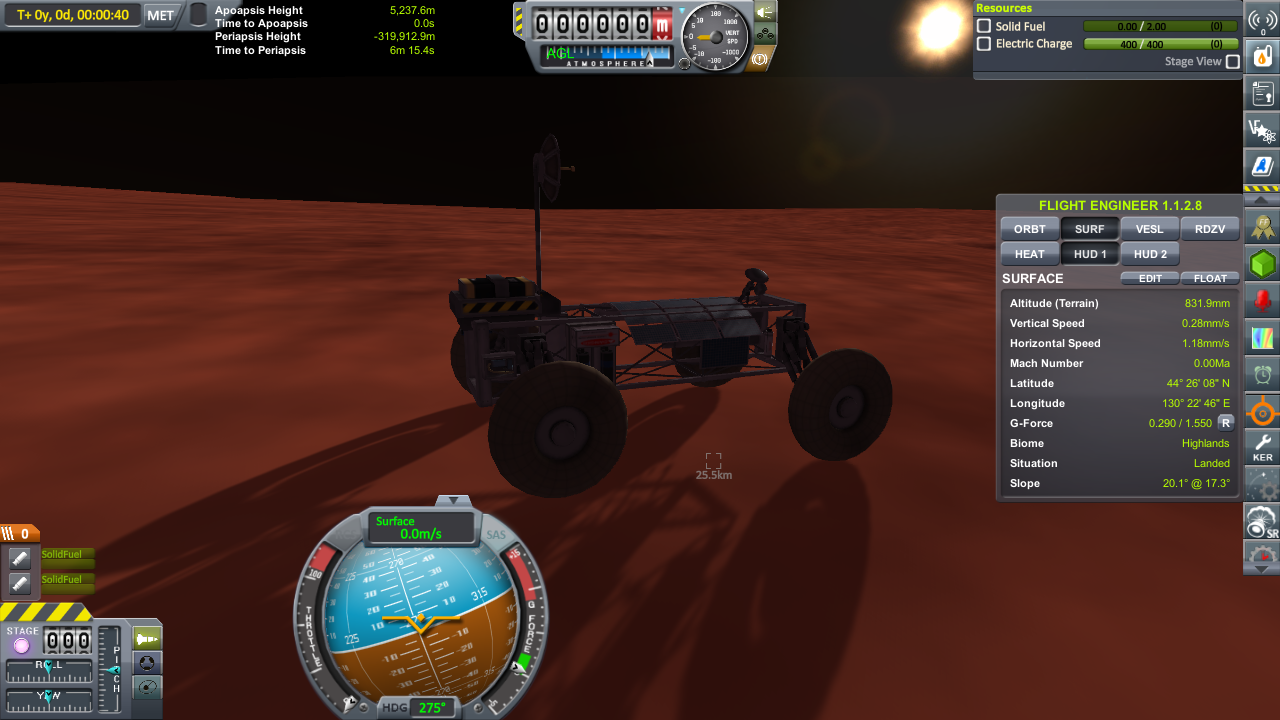
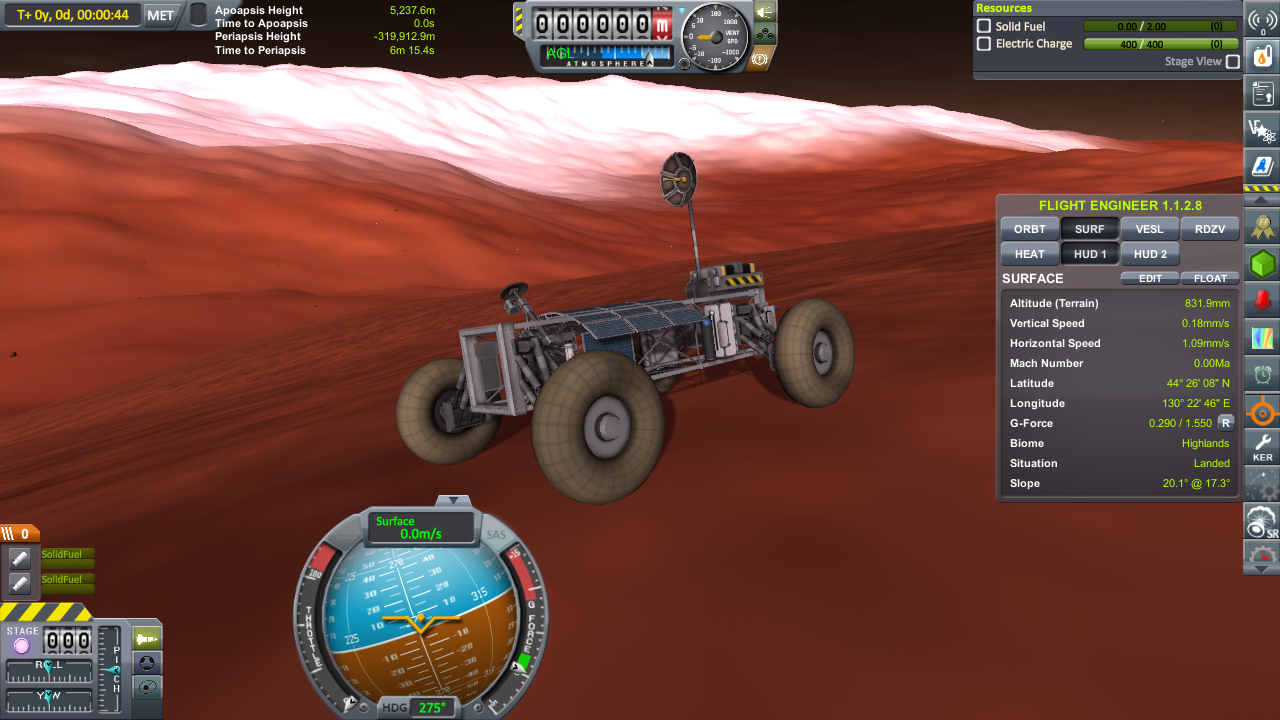













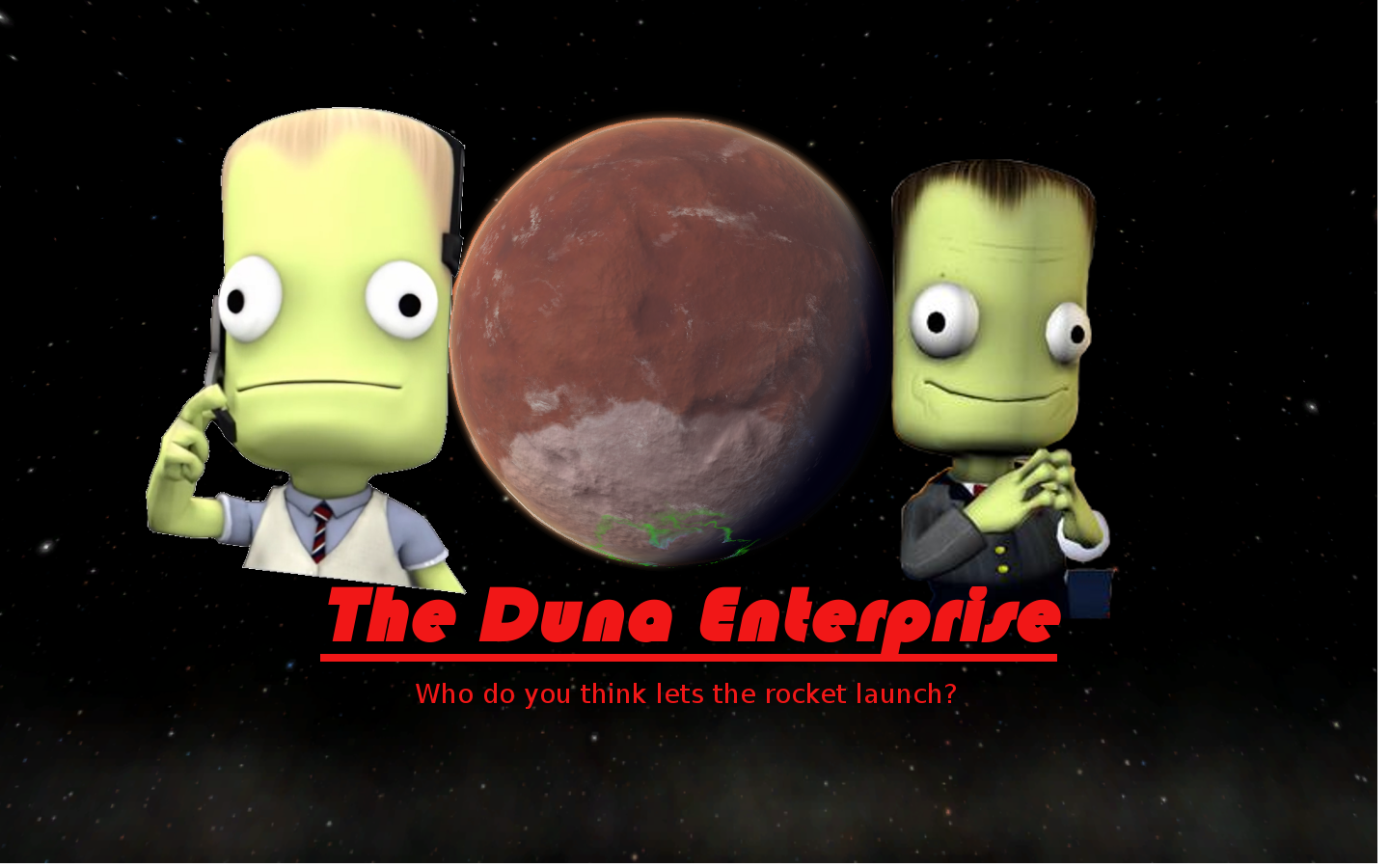
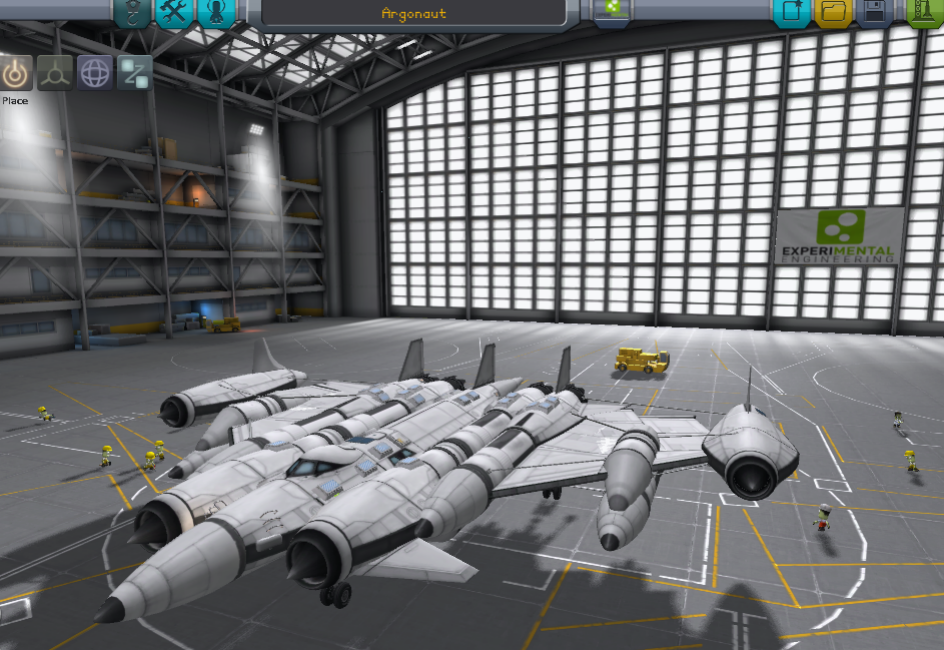
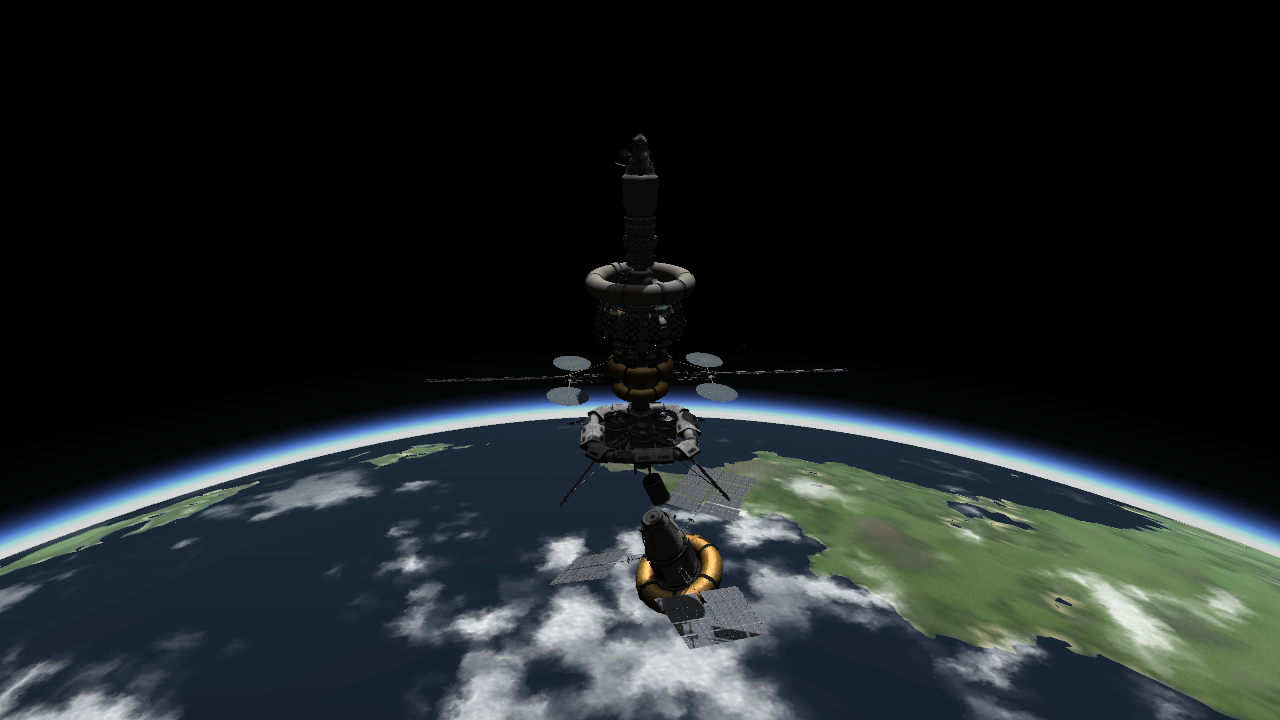
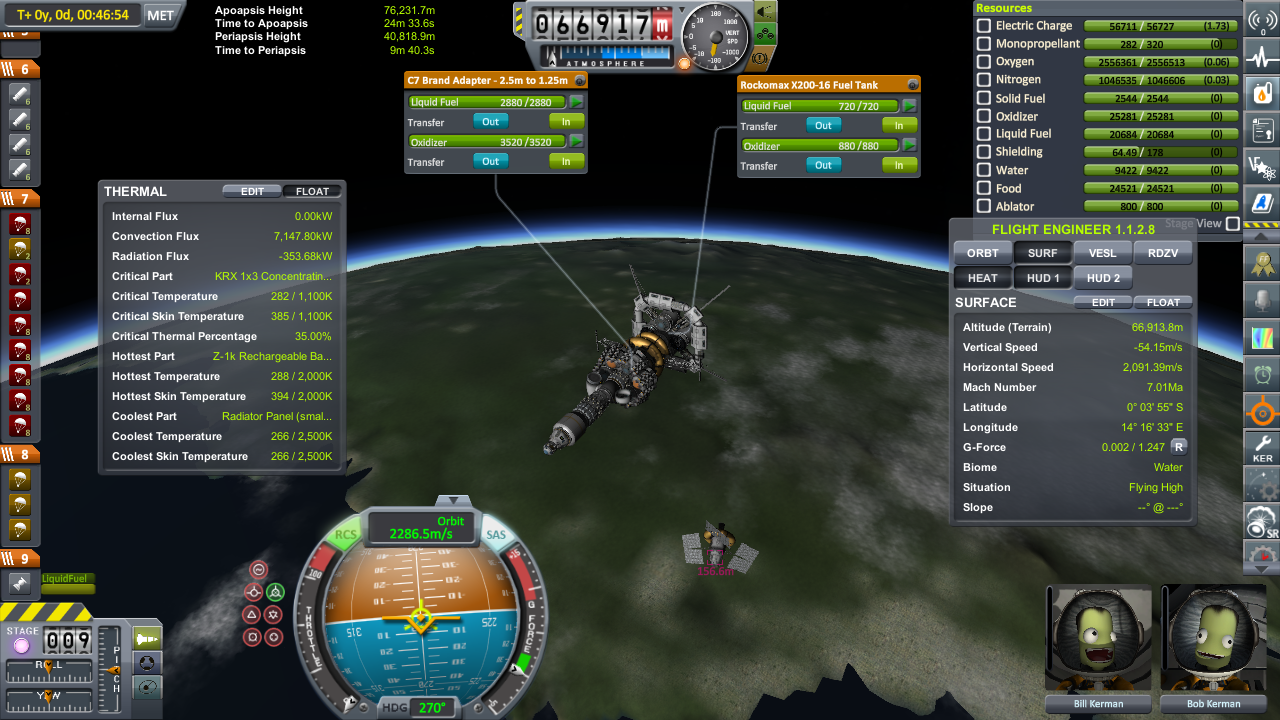
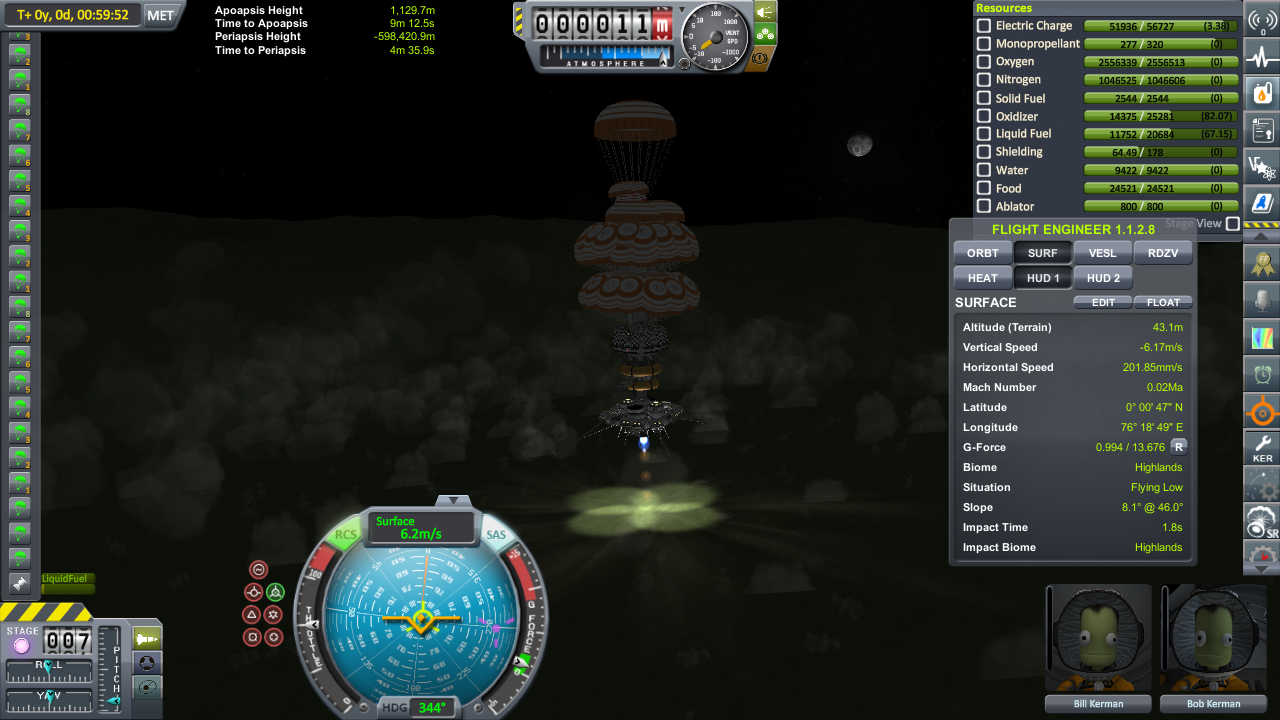
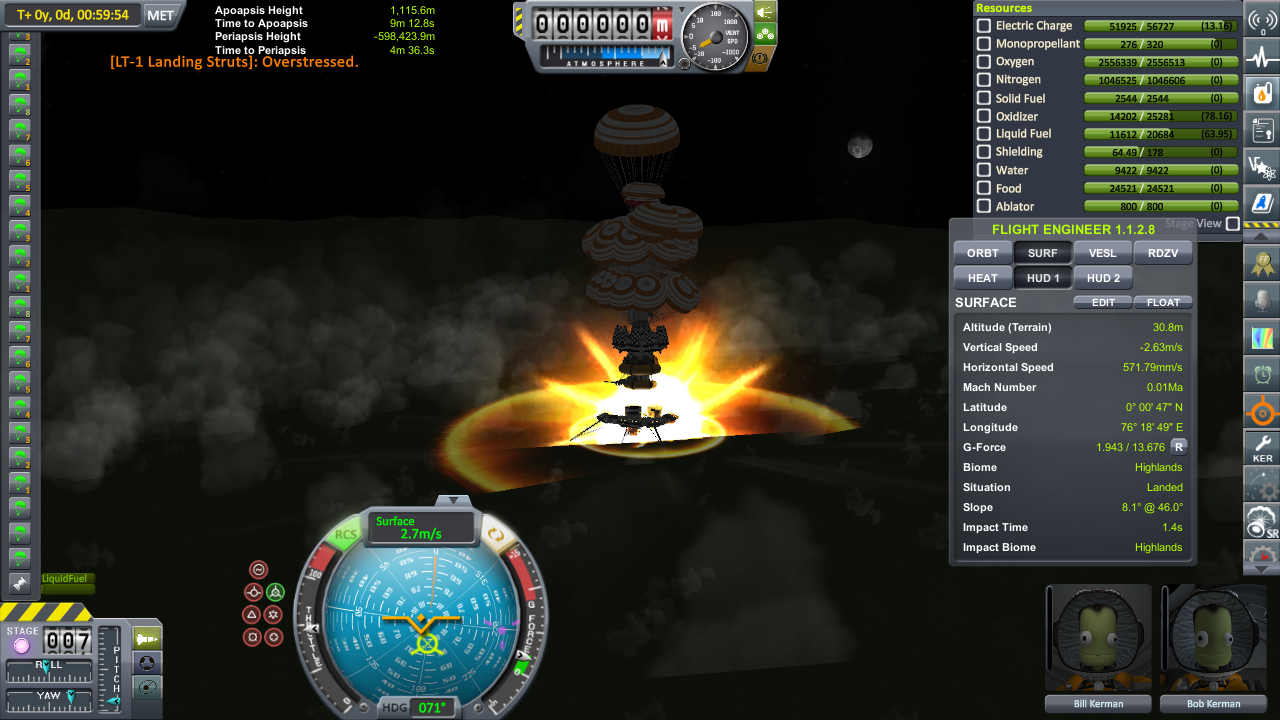
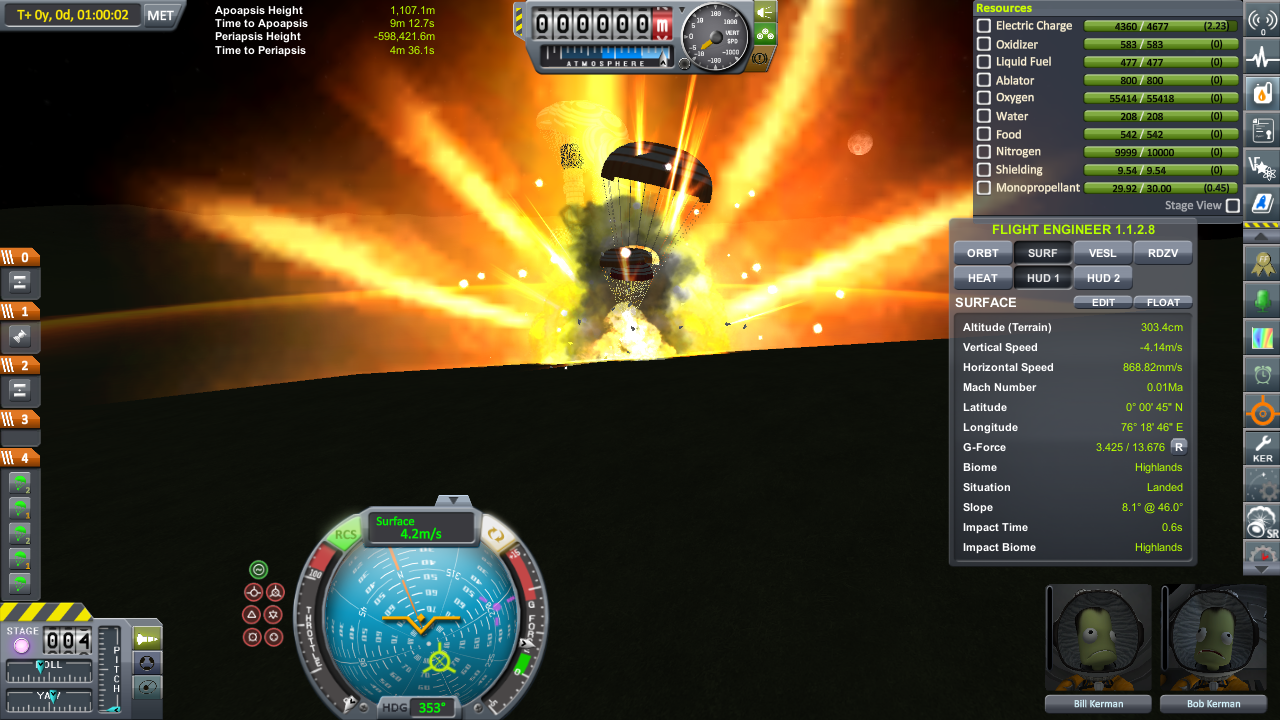
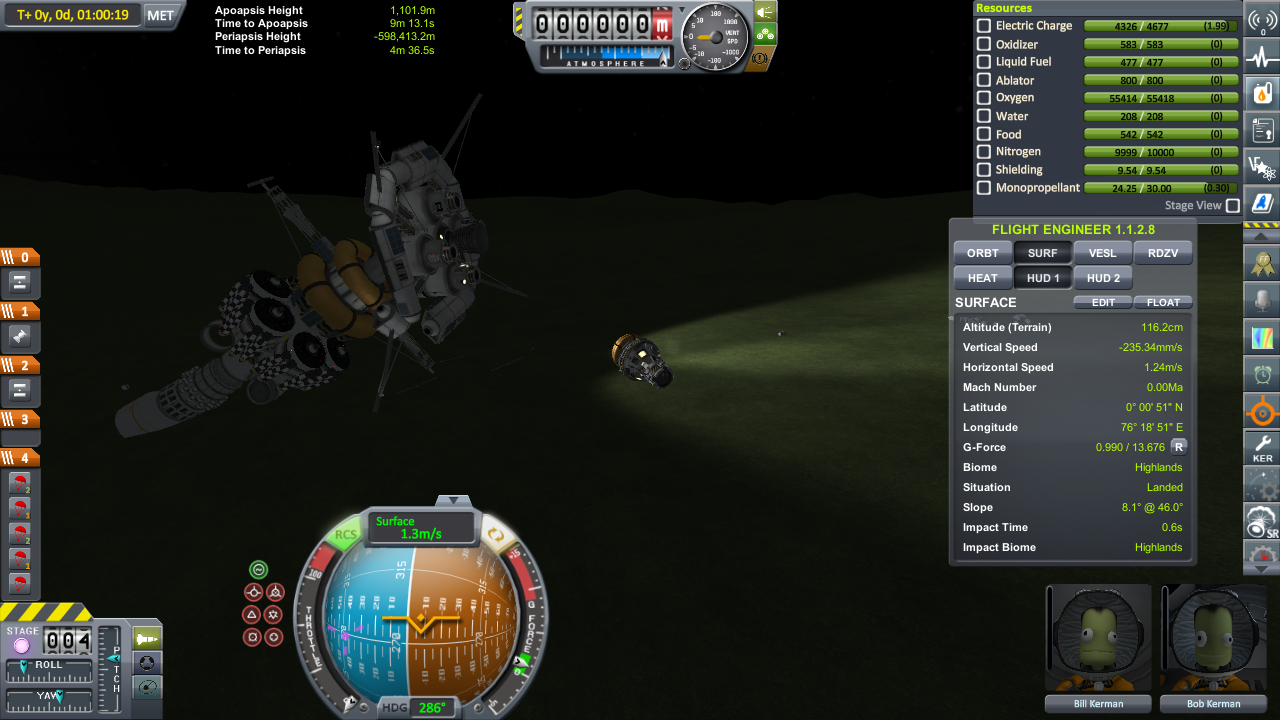
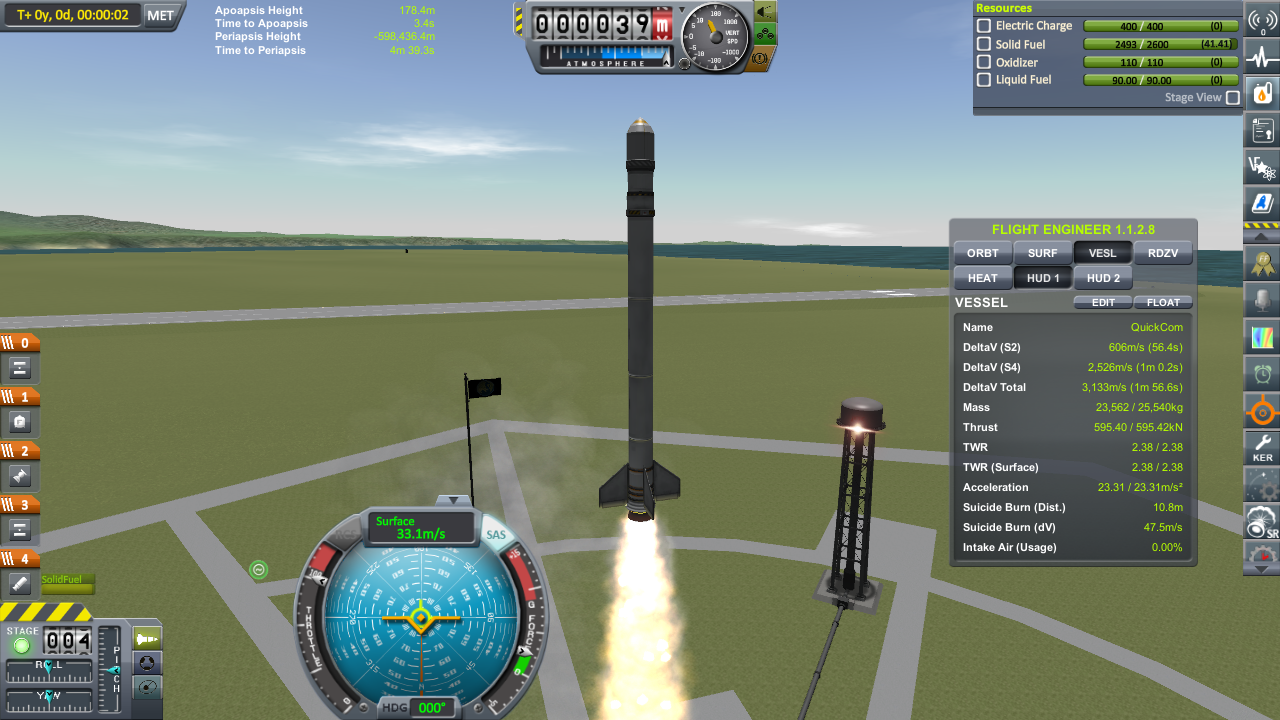
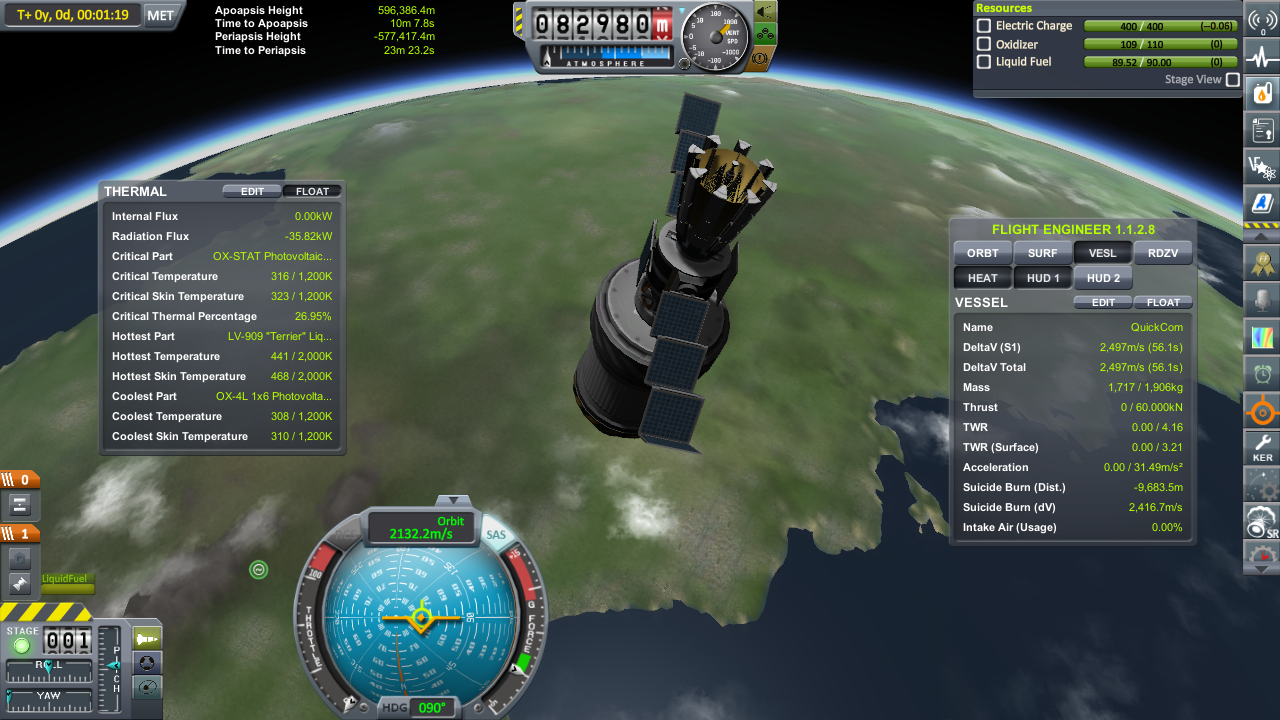


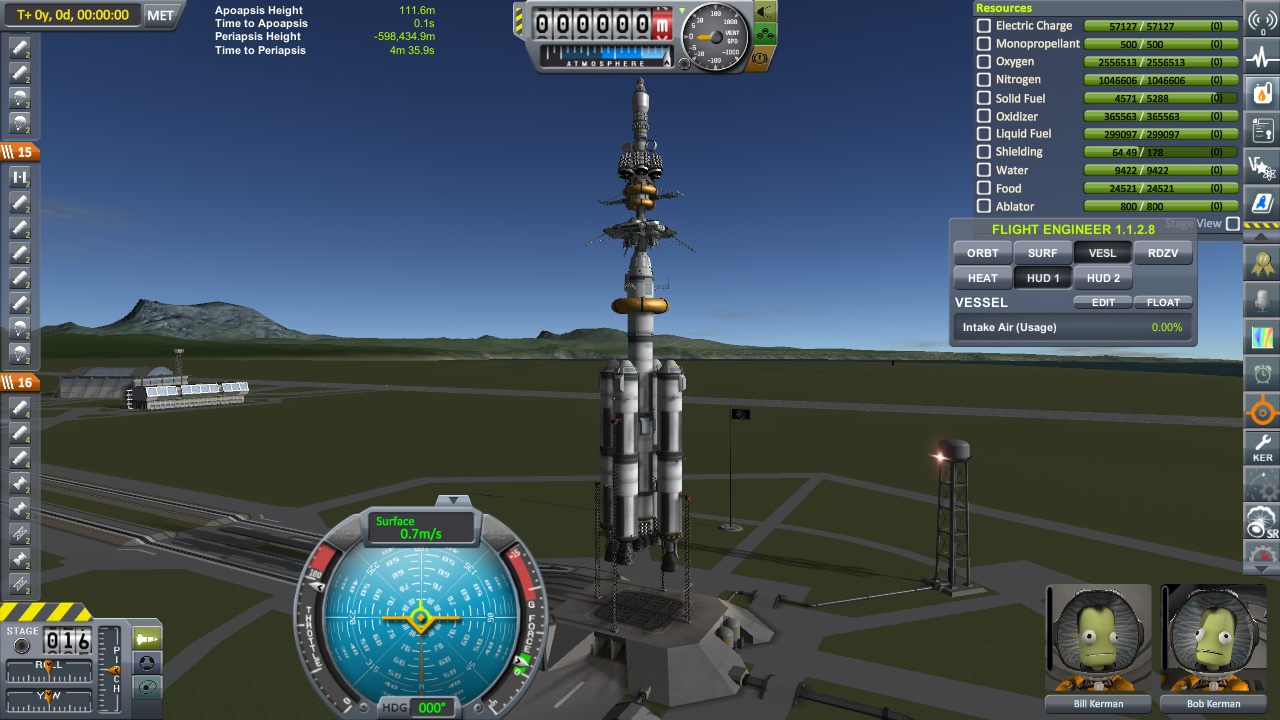

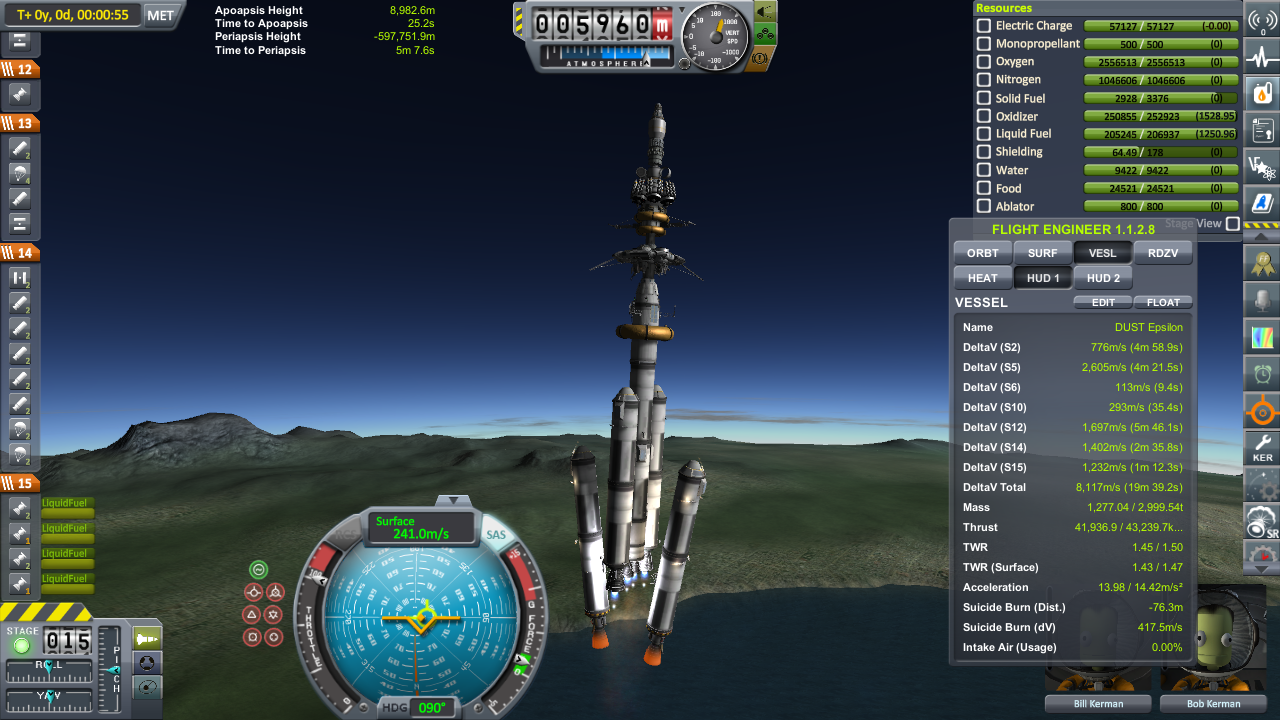
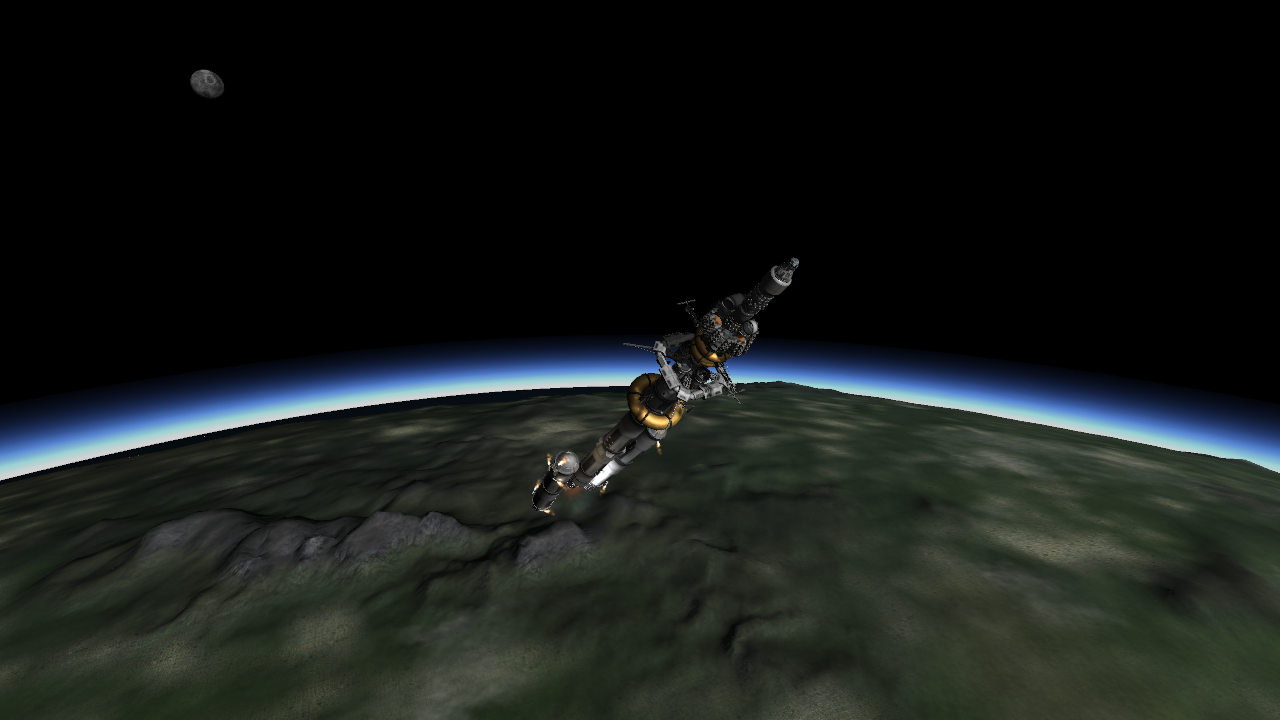
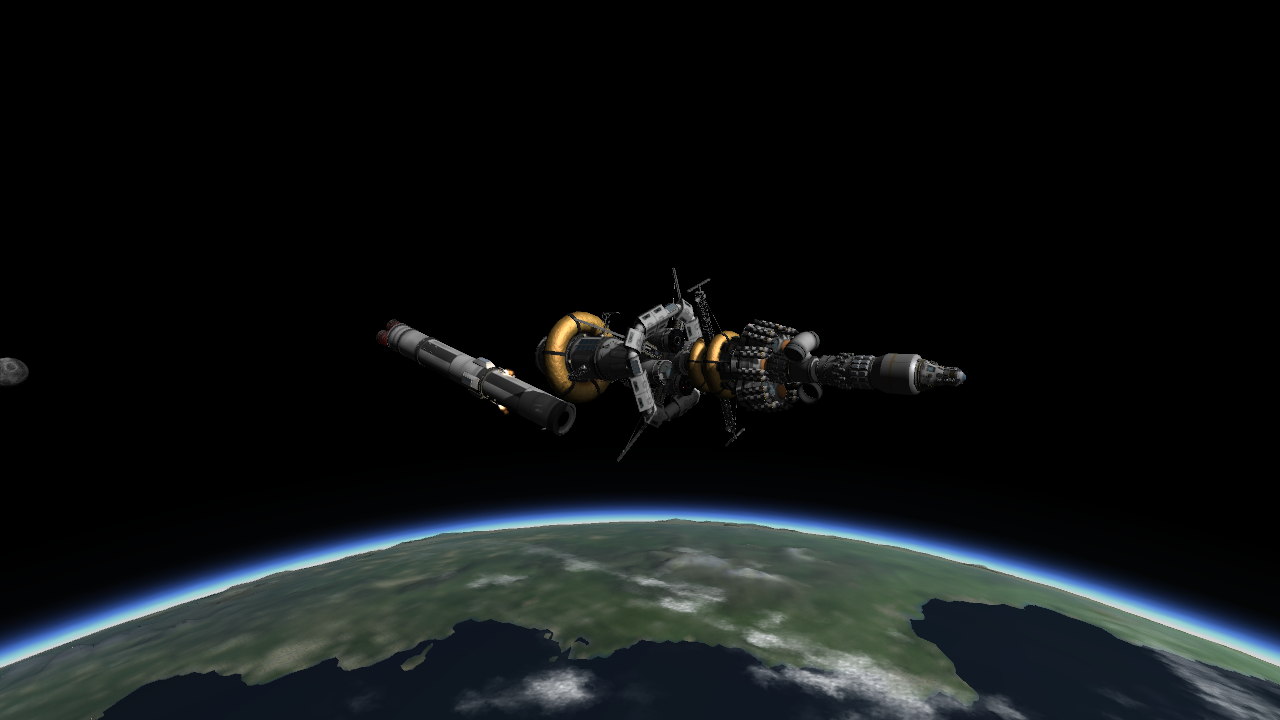
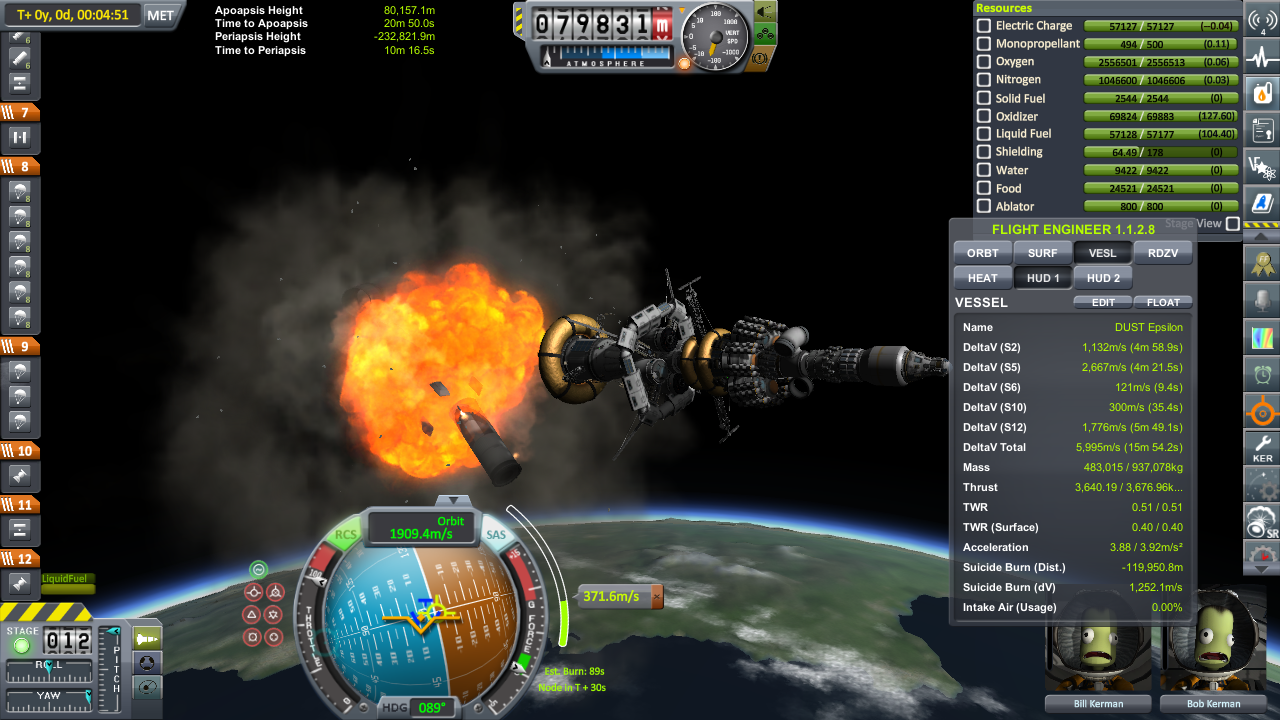
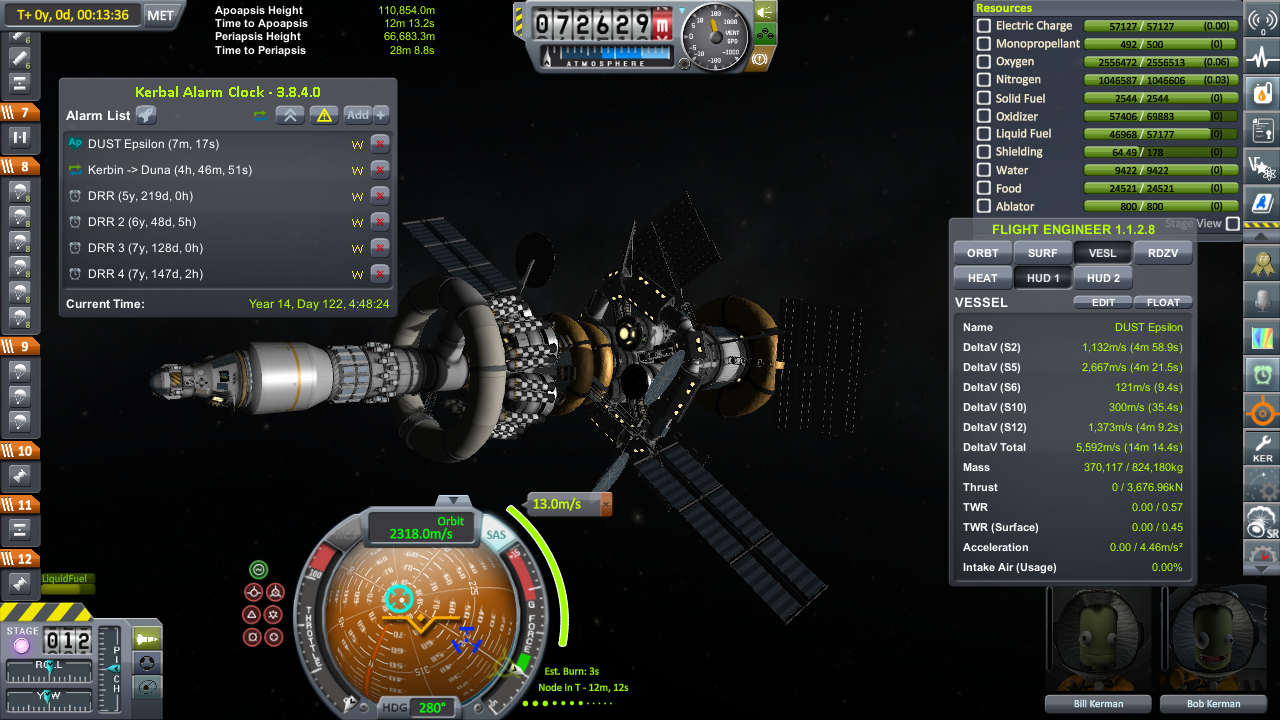
SpaceX Discussion Thread
in Science & Spaceflight
Posted
I still read that in Ahnold's voice.